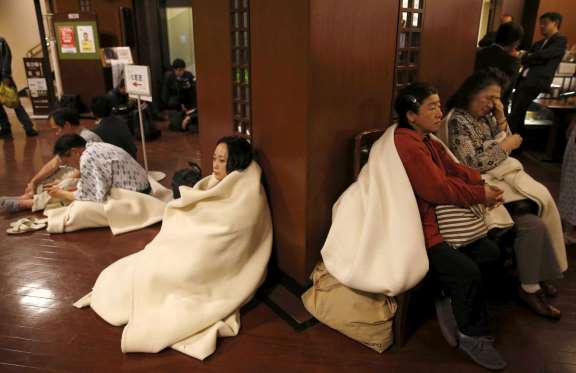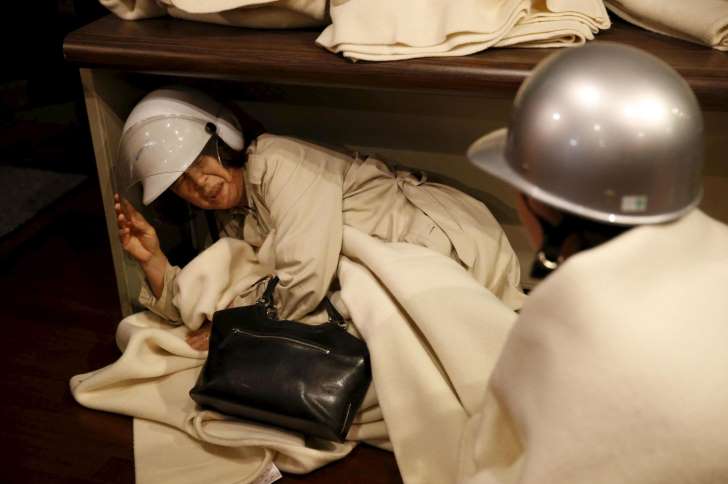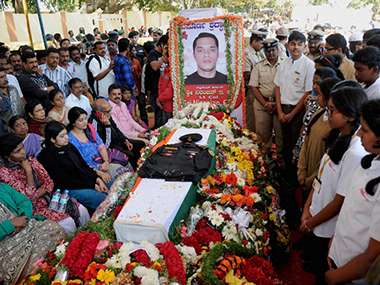April 15, 2016
A second earthquake struck southern Japan on April 16, 2016, this one measuring a magnitude 7.1. A tsunami warning had been lifted but there are some reports of injuries and people trapped in the Kumamoto area.

April 15, 2016
A second earthquake struck southern Japan on April 16, 2016, this one measuring a magnitude 7.1. A tsunami warning had been lifted but there are some reports of injuries and people trapped in the Kumamoto area.

(Pictured) Hotel guests gather at a hotel lobby after another earthquake hit the area in Kumamoto, southern Japan, on April 16, 2016.
TOKYO, JAPAN – A magnitude 7.3 earthquake struck southern Japan early on Saturday, killing at least one person, injuring many more and bringing down buildings, local media reported, just over a day after a quake killed nine people in the same region.
The authorities warned of damage over a wide area, as reports came in of people being trapped in collapsed buildings, fires and power outages.
Residents living near a dam were told to leave because of fears it might crumble, broadcaster NHK said.
Saturday's trembler triggered a tsunami advisory, although it was later lifted and no irregularities were reported at three nuclear power plants in the area, a senior government official said.
Breakingnews.com coverage of Japan's quakes
People still reeling from Thursday's shock poured onto the streets after the Saturday quake.
Kyodo news agency said one person was confirmed dead. NHK reported that nearly 400 people were being treated in hospitals, but that figure included "people who don't feel well", so it was not clear how many serious injuries there were.
Media reported fresh damage, including collapsed buildings and roads. A fire erupted in a what appeared to be an apartment building in Yatsushiro city, while some people were trapped in a nursing home in the town of Mashiki, according to NHK.
The epicenter of the quake was near the city of Kumamoto and measured at a shallow depth of 10 km, the U.S. Geological Survey said. The entire city of 730,000 was without power.
Prime Minister Shinzo Abe, arriving at his office, told reporters the government was making every effort to determine the extent of the damage, carry out rescue and recovery, and to get accurate information to citizens.
"It's possible that there may be damage over a wide area," Abe said.

A woman takes shelter after another earthquake hit the area at a hotel in Kumamoto, southern Japan, in this photo taken by Kyodo April 16, 2016.
SHOCKS AND AFTERSHOCKS
The earthquake on Thursday evening in the same region was of 6.4 magnitude and experts said the two tectonic events could be linked.
"Thursday's quake might have been a foreshock of this one," Shinji Toda, a professor at Tohoku University, told NHK.
Several aftershocks rattled the region later on Saturday, including two of nearly 6 magnitude, and the Meteorological Agency warned of more.
Television footage showed many frightened people wrapped in blankets sitting outside their homes.
The Japan Meteorological Agency initially said the Saturday quake was 7.1 magnitude but later revised it up to 7.3.
Soon after the quake struck, the agency issued a tsunami advisory, which identifies the presence of a marine threat and asks people to leave coastal regions, for the Ariake and Yatsushiro seas.
NHK said the advisory suggested a possible wave of one metre in height. The advisory was later lifted.
"We are making every effort to respond to this quake," Chief Cabinet Secretary Yoshihide Suga told reporters.
He confirmed there were no problems at any of the three nuclear power plants in the region.
A magnitude 9 quake in March 2011, to the north of Tokyo, touched off a massive tsunami and nuclear meltdowns at Fukushima. Nearly 20,000 people were killed in the tsunami.
Japan is on the seismically active "ring of fire" around the Pacific Ocean and has building codes aimed at helping structures withstand earthquakes.
The 2011 quake temporarily crippled part of Japan's auto supply chain, but some companies have since adjusted the industry's "Just in Time" production philosophy in a bid to limit any repeat of the costly disruption.
Courtesy: Reuters

















































































































